Anatomy and Physiology of the Human Body: Systems and Functions
VerifiedAdded on 2023/01/13
|17
|4181
|70
Report
AI Summary
This report provides a comprehensive overview of human anatomy and physiology, focusing on the structure and function of various body systems. It begins by outlining the function of a human body cell, detailing its role in osmosis and diffusion. The report then describes the structure and function of different body systems, including the digestive, respiratory, and circulatory systems, emphasizing their roles in maintaining health. It further explains how these systems cooperate to sustain life and health, highlighting the interconnectedness of the human body. The report also covers the role of various organs and their physiological functions. This report is valuable for understanding the complexities of human anatomy and physiology and how the different systems work together to maintain overall well-being. The report also discusses the impact of abnormal functioning of the digestive system, which may results into several problems like GERD, gallstones, and other diseases.
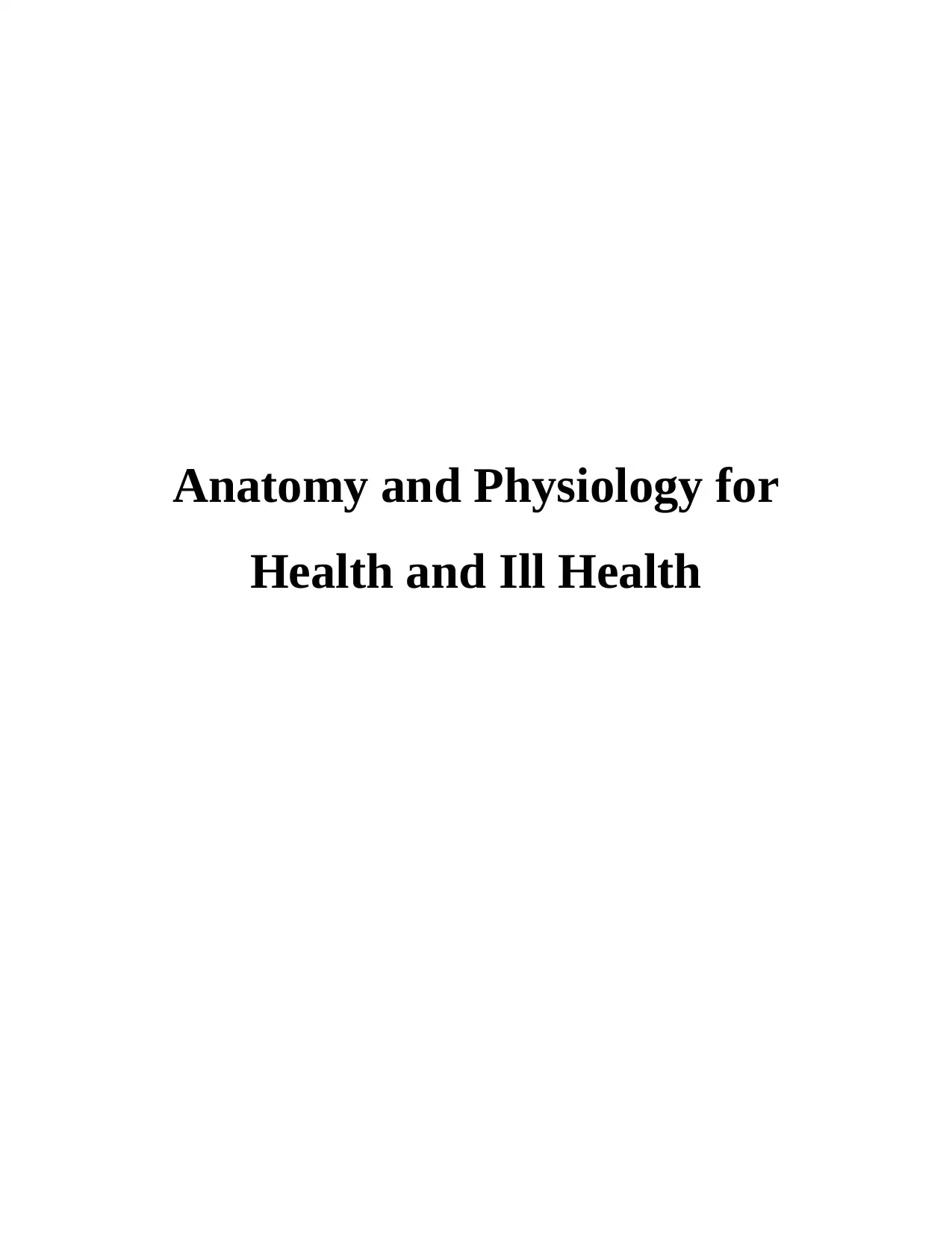
Anatomy and Physiology for
Health and Ill Health
Health and Ill Health
Paraphrase This Document
Need a fresh take? Get an instant paraphrase of this document with our AI Paraphraser
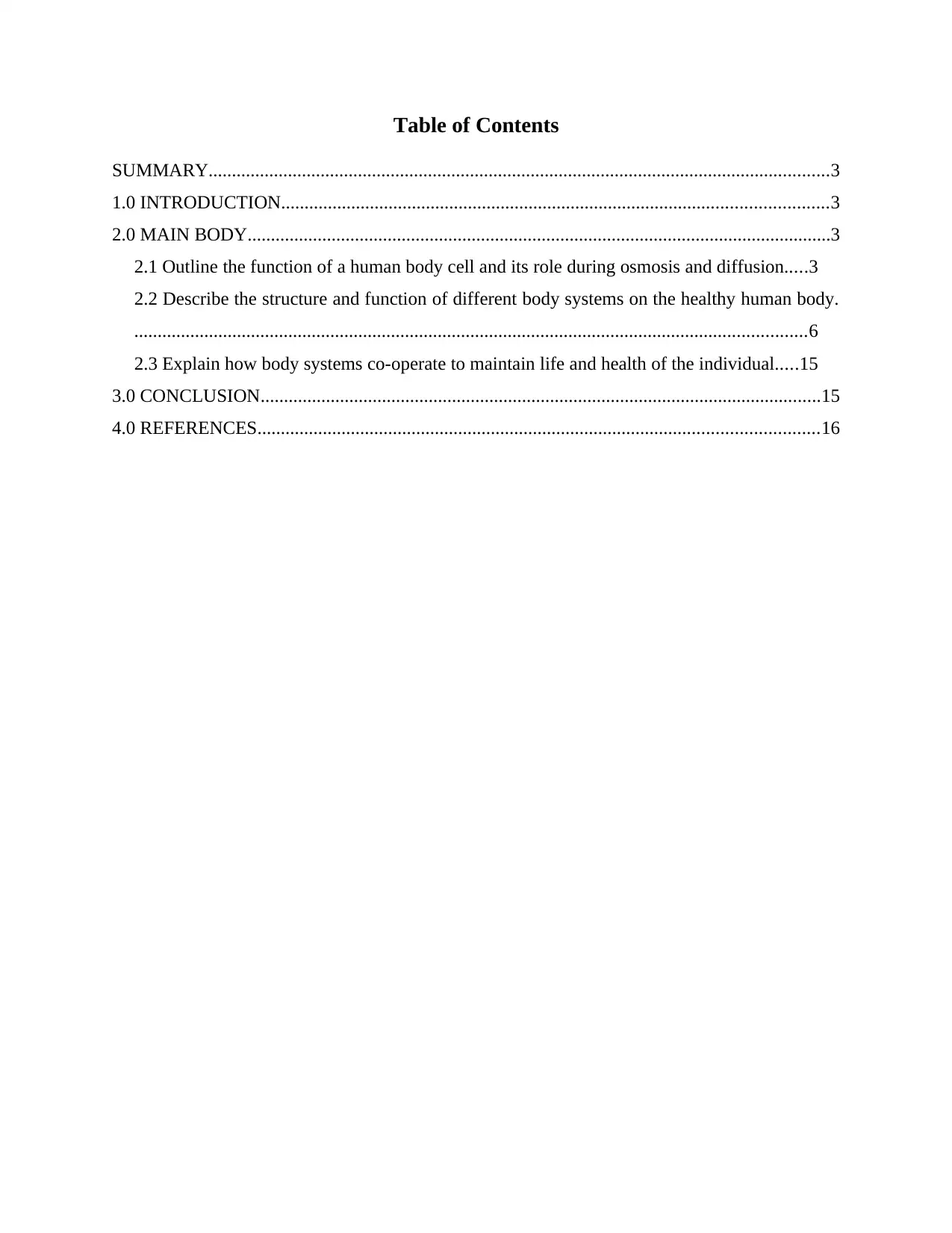
Table of Contents
SUMMARY.....................................................................................................................................3
1.0 INTRODUCTION.....................................................................................................................3
2.0 MAIN BODY.............................................................................................................................3
2.1 Outline the function of a human body cell and its role during osmosis and diffusion.....3
2.2 Describe the structure and function of different body systems on the healthy human body.
................................................................................................................................................6
2.3 Explain how body systems co-operate to maintain life and health of the individual.....15
3.0 CONCLUSION........................................................................................................................15
4.0 REFERENCES........................................................................................................................16
SUMMARY.....................................................................................................................................3
1.0 INTRODUCTION.....................................................................................................................3
2.0 MAIN BODY.............................................................................................................................3
2.1 Outline the function of a human body cell and its role during osmosis and diffusion.....3
2.2 Describe the structure and function of different body systems on the healthy human body.
................................................................................................................................................6
2.3 Explain how body systems co-operate to maintain life and health of the individual.....15
3.0 CONCLUSION........................................................................................................................15
4.0 REFERENCES........................................................................................................................16
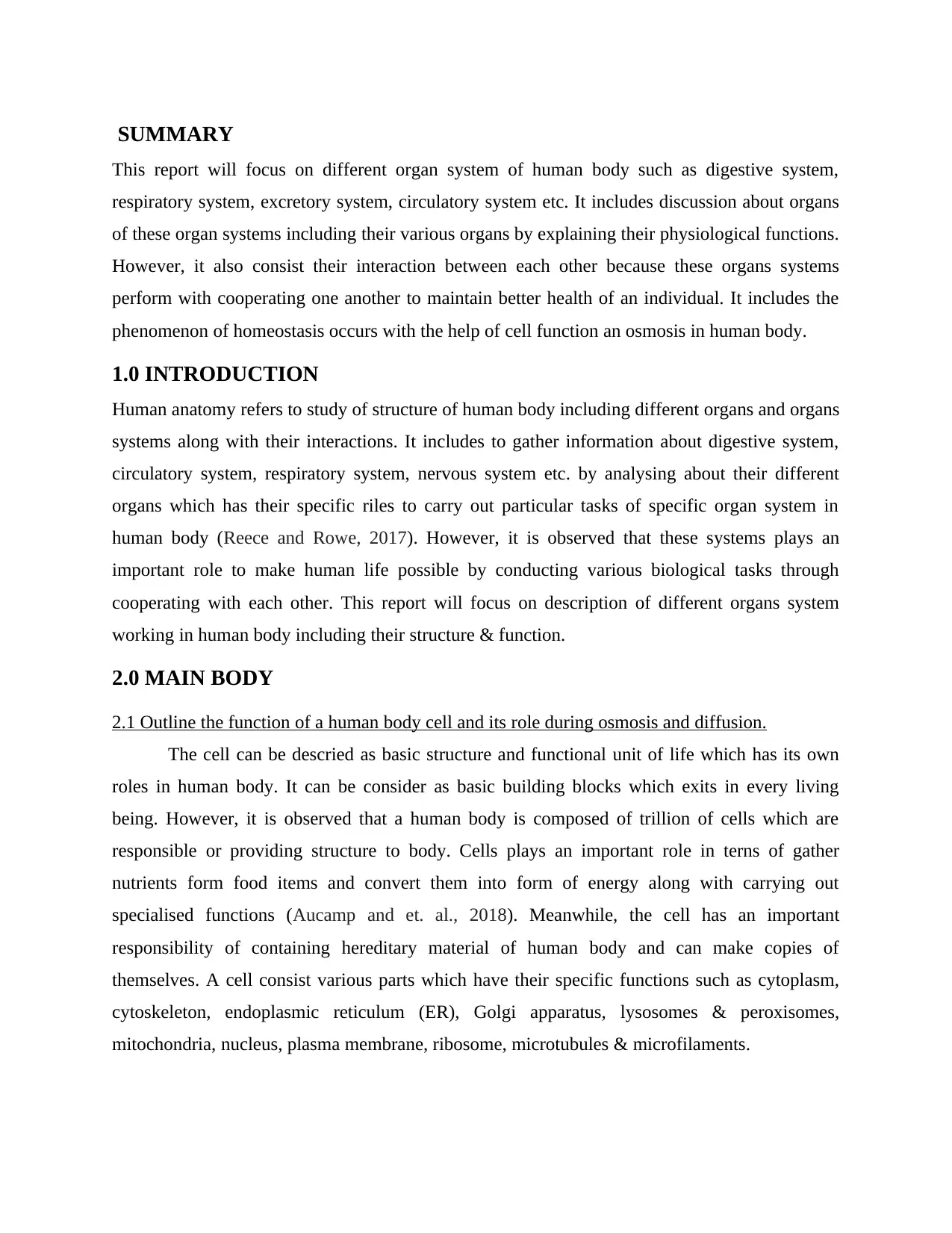
SUMMARY
This report will focus on different organ system of human body such as digestive system,
respiratory system, excretory system, circulatory system etc. It includes discussion about organs
of these organ systems including their various organs by explaining their physiological functions.
However, it also consist their interaction between each other because these organs systems
perform with cooperating one another to maintain better health of an individual. It includes the
phenomenon of homeostasis occurs with the help of cell function an osmosis in human body.
1.0 INTRODUCTION
Human anatomy refers to study of structure of human body including different organs and organs
systems along with their interactions. It includes to gather information about digestive system,
circulatory system, respiratory system, nervous system etc. by analysing about their different
organs which has their specific riles to carry out particular tasks of specific organ system in
human body (Reece and Rowe, 2017). However, it is observed that these systems plays an
important role to make human life possible by conducting various biological tasks through
cooperating with each other. This report will focus on description of different organs system
working in human body including their structure & function.
2.0 MAIN BODY
2.1 Outline the function of a human body cell and its role during osmosis and diffusion.
The cell can be descried as basic structure and functional unit of life which has its own
roles in human body. It can be consider as basic building blocks which exits in every living
being. However, it is observed that a human body is composed of trillion of cells which are
responsible or providing structure to body. Cells plays an important role in terns of gather
nutrients form food items and convert them into form of energy along with carrying out
specialised functions (Aucamp and et. al., 2018). Meanwhile, the cell has an important
responsibility of containing hereditary material of human body and can make copies of
themselves. A cell consist various parts which have their specific functions such as cytoplasm,
cytoskeleton, endoplasmic reticulum (ER), Golgi apparatus, lysosomes & peroxisomes,
mitochondria, nucleus, plasma membrane, ribosome, microtubules & microfilaments.
This report will focus on different organ system of human body such as digestive system,
respiratory system, excretory system, circulatory system etc. It includes discussion about organs
of these organ systems including their various organs by explaining their physiological functions.
However, it also consist their interaction between each other because these organs systems
perform with cooperating one another to maintain better health of an individual. It includes the
phenomenon of homeostasis occurs with the help of cell function an osmosis in human body.
1.0 INTRODUCTION
Human anatomy refers to study of structure of human body including different organs and organs
systems along with their interactions. It includes to gather information about digestive system,
circulatory system, respiratory system, nervous system etc. by analysing about their different
organs which has their specific riles to carry out particular tasks of specific organ system in
human body (Reece and Rowe, 2017). However, it is observed that these systems plays an
important role to make human life possible by conducting various biological tasks through
cooperating with each other. This report will focus on description of different organs system
working in human body including their structure & function.
2.0 MAIN BODY
2.1 Outline the function of a human body cell and its role during osmosis and diffusion.
The cell can be descried as basic structure and functional unit of life which has its own
roles in human body. It can be consider as basic building blocks which exits in every living
being. However, it is observed that a human body is composed of trillion of cells which are
responsible or providing structure to body. Cells plays an important role in terns of gather
nutrients form food items and convert them into form of energy along with carrying out
specialised functions (Aucamp and et. al., 2018). Meanwhile, the cell has an important
responsibility of containing hereditary material of human body and can make copies of
themselves. A cell consist various parts which have their specific functions such as cytoplasm,
cytoskeleton, endoplasmic reticulum (ER), Golgi apparatus, lysosomes & peroxisomes,
mitochondria, nucleus, plasma membrane, ribosome, microtubules & microfilaments.
⊘ This is a preview!⊘
Do you want full access?
Subscribe today to unlock all pages.

Trusted by 1+ million students worldwide
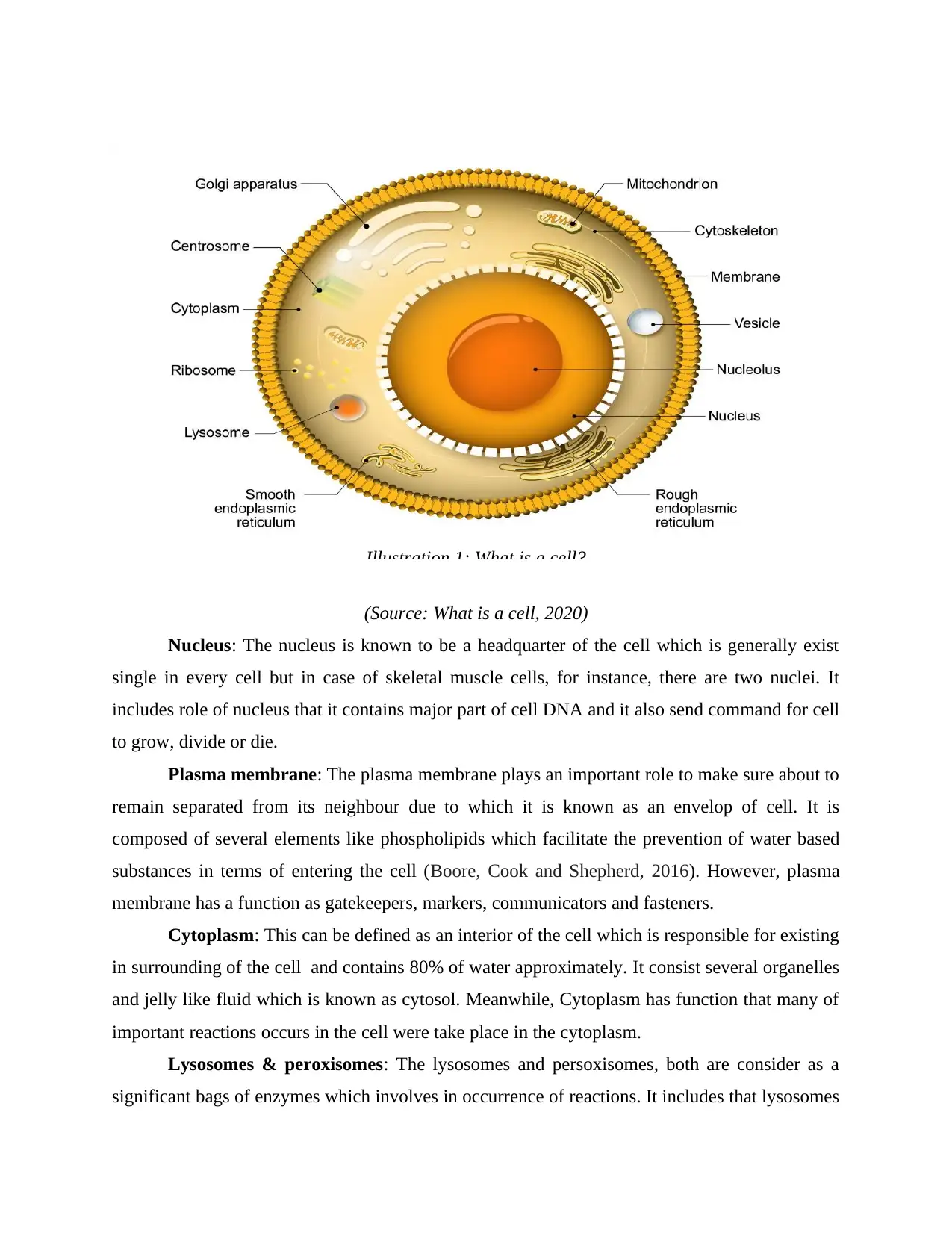
(Source: What is a cell, 2020)
Nucleus: The nucleus is known to be a headquarter of the cell which is generally exist
single in every cell but in case of skeletal muscle cells, for instance, there are two nuclei. It
includes role of nucleus that it contains major part of cell DNA and it also send command for cell
to grow, divide or die.
Plasma membrane: The plasma membrane plays an important role to make sure about to
remain separated from its neighbour due to which it is known as an envelop of cell. It is
composed of several elements like phospholipids which facilitate the prevention of water based
substances in terms of entering the cell (Boore, Cook and Shepherd, 2016). However, plasma
membrane has a function as gatekeepers, markers, communicators and fasteners.
Cytoplasm: This can be defined as an interior of the cell which is responsible for existing
in surrounding of the cell and contains 80% of water approximately. It consist several organelles
and jelly like fluid which is known as cytosol. Meanwhile, Cytoplasm has function that many of
important reactions occurs in the cell were take place in the cytoplasm.
Lysosomes & peroxisomes: The lysosomes and persoxisomes, both are consider as a
significant bags of enzymes which involves in occurrence of reactions. It includes that lysosomes
Illustration 1: What is a cell?
Nucleus: The nucleus is known to be a headquarter of the cell which is generally exist
single in every cell but in case of skeletal muscle cells, for instance, there are two nuclei. It
includes role of nucleus that it contains major part of cell DNA and it also send command for cell
to grow, divide or die.
Plasma membrane: The plasma membrane plays an important role to make sure about to
remain separated from its neighbour due to which it is known as an envelop of cell. It is
composed of several elements like phospholipids which facilitate the prevention of water based
substances in terms of entering the cell (Boore, Cook and Shepherd, 2016). However, plasma
membrane has a function as gatekeepers, markers, communicators and fasteners.
Cytoplasm: This can be defined as an interior of the cell which is responsible for existing
in surrounding of the cell and contains 80% of water approximately. It consist several organelles
and jelly like fluid which is known as cytosol. Meanwhile, Cytoplasm has function that many of
important reactions occurs in the cell were take place in the cytoplasm.
Lysosomes & peroxisomes: The lysosomes and persoxisomes, both are consider as a
significant bags of enzymes which involves in occurrence of reactions. It includes that lysosomes
Illustration 1: What is a cell?
Paraphrase This Document
Need a fresh take? Get an instant paraphrase of this document with our AI Paraphraser
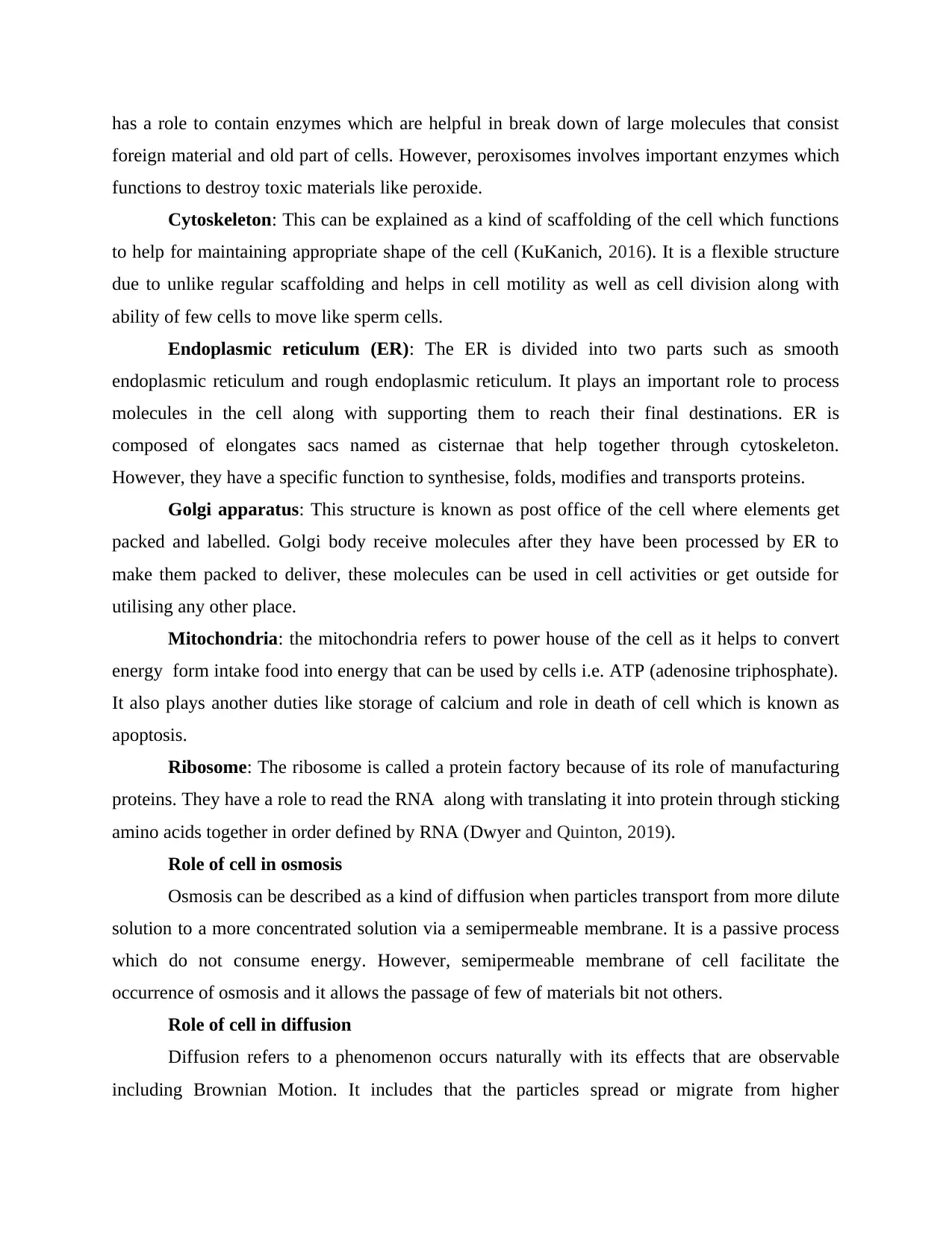
has a role to contain enzymes which are helpful in break down of large molecules that consist
foreign material and old part of cells. However, peroxisomes involves important enzymes which
functions to destroy toxic materials like peroxide.
Cytoskeleton: This can be explained as a kind of scaffolding of the cell which functions
to help for maintaining appropriate shape of the cell (KuKanich, 2016). It is a flexible structure
due to unlike regular scaffolding and helps in cell motility as well as cell division along with
ability of few cells to move like sperm cells.
Endoplasmic reticulum (ER): The ER is divided into two parts such as smooth
endoplasmic reticulum and rough endoplasmic reticulum. It plays an important role to process
molecules in the cell along with supporting them to reach their final destinations. ER is
composed of elongates sacs named as cisternae that help together through cytoskeleton.
However, they have a specific function to synthesise, folds, modifies and transports proteins.
Golgi apparatus: This structure is known as post office of the cell where elements get
packed and labelled. Golgi body receive molecules after they have been processed by ER to
make them packed to deliver, these molecules can be used in cell activities or get outside for
utilising any other place.
Mitochondria: the mitochondria refers to power house of the cell as it helps to convert
energy form intake food into energy that can be used by cells i.e. ATP (adenosine triphosphate).
It also plays another duties like storage of calcium and role in death of cell which is known as
apoptosis.
Ribosome: The ribosome is called a protein factory because of its role of manufacturing
proteins. They have a role to read the RNA along with translating it into protein through sticking
amino acids together in order defined by RNA (Dwyer and Quinton, 2019).
Role of cell in osmosis
Osmosis can be described as a kind of diffusion when particles transport from more dilute
solution to a more concentrated solution via a semipermeable membrane. It is a passive process
which do not consume energy. However, semipermeable membrane of cell facilitate the
occurrence of osmosis and it allows the passage of few of materials bit not others.
Role of cell in diffusion
Diffusion refers to a phenomenon occurs naturally with its effects that are observable
including Brownian Motion. It includes that the particles spread or migrate from higher
foreign material and old part of cells. However, peroxisomes involves important enzymes which
functions to destroy toxic materials like peroxide.
Cytoskeleton: This can be explained as a kind of scaffolding of the cell which functions
to help for maintaining appropriate shape of the cell (KuKanich, 2016). It is a flexible structure
due to unlike regular scaffolding and helps in cell motility as well as cell division along with
ability of few cells to move like sperm cells.
Endoplasmic reticulum (ER): The ER is divided into two parts such as smooth
endoplasmic reticulum and rough endoplasmic reticulum. It plays an important role to process
molecules in the cell along with supporting them to reach their final destinations. ER is
composed of elongates sacs named as cisternae that help together through cytoskeleton.
However, they have a specific function to synthesise, folds, modifies and transports proteins.
Golgi apparatus: This structure is known as post office of the cell where elements get
packed and labelled. Golgi body receive molecules after they have been processed by ER to
make them packed to deliver, these molecules can be used in cell activities or get outside for
utilising any other place.
Mitochondria: the mitochondria refers to power house of the cell as it helps to convert
energy form intake food into energy that can be used by cells i.e. ATP (adenosine triphosphate).
It also plays another duties like storage of calcium and role in death of cell which is known as
apoptosis.
Ribosome: The ribosome is called a protein factory because of its role of manufacturing
proteins. They have a role to read the RNA along with translating it into protein through sticking
amino acids together in order defined by RNA (Dwyer and Quinton, 2019).
Role of cell in osmosis
Osmosis can be described as a kind of diffusion when particles transport from more dilute
solution to a more concentrated solution via a semipermeable membrane. It is a passive process
which do not consume energy. However, semipermeable membrane of cell facilitate the
occurrence of osmosis and it allows the passage of few of materials bit not others.
Role of cell in diffusion
Diffusion refers to a phenomenon occurs naturally with its effects that are observable
including Brownian Motion. It includes that the particles spread or migrate from higher
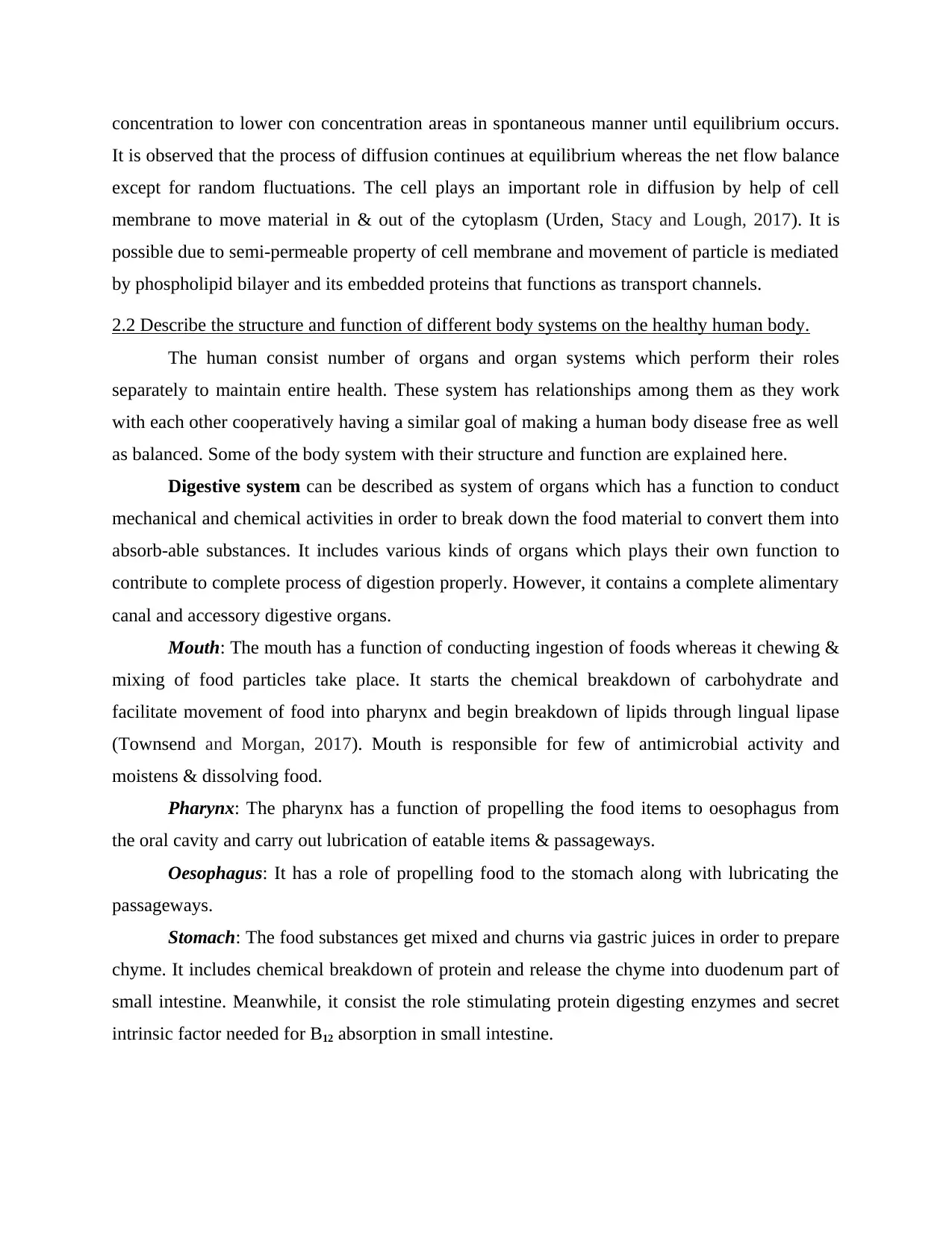
concentration to lower con concentration areas in spontaneous manner until equilibrium occurs.
It is observed that the process of diffusion continues at equilibrium whereas the net flow balance
except for random fluctuations. The cell plays an important role in diffusion by help of cell
membrane to move material in & out of the cytoplasm (Urden, Stacy and Lough, 2017). It is
possible due to semi-permeable property of cell membrane and movement of particle is mediated
by phospholipid bilayer and its embedded proteins that functions as transport channels.
2.2 Describe the structure and function of different body systems on the healthy human body.
The human consist number of organs and organ systems which perform their roles
separately to maintain entire health. These system has relationships among them as they work
with each other cooperatively having a similar goal of making a human body disease free as well
as balanced. Some of the body system with their structure and function are explained here.
Digestive system can be described as system of organs which has a function to conduct
mechanical and chemical activities in order to break down the food material to convert them into
absorb-able substances. It includes various kinds of organs which plays their own function to
contribute to complete process of digestion properly. However, it contains a complete alimentary
canal and accessory digestive organs.
Mouth: The mouth has a function of conducting ingestion of foods whereas it chewing &
mixing of food particles take place. It starts the chemical breakdown of carbohydrate and
facilitate movement of food into pharynx and begin breakdown of lipids through lingual lipase
(Townsend and Morgan, 2017). Mouth is responsible for few of antimicrobial activity and
moistens & dissolving food.
Pharynx: The pharynx has a function of propelling the food items to oesophagus from
the oral cavity and carry out lubrication of eatable items & passageways.
Oesophagus: It has a role of propelling food to the stomach along with lubricating the
passageways.
Stomach: The food substances get mixed and churns via gastric juices in order to prepare
chyme. It includes chemical breakdown of protein and release the chyme into duodenum part of
small intestine. Meanwhile, it consist the role stimulating protein digesting enzymes and secret
intrinsic factor needed for B12 absorption in small intestine.
It is observed that the process of diffusion continues at equilibrium whereas the net flow balance
except for random fluctuations. The cell plays an important role in diffusion by help of cell
membrane to move material in & out of the cytoplasm (Urden, Stacy and Lough, 2017). It is
possible due to semi-permeable property of cell membrane and movement of particle is mediated
by phospholipid bilayer and its embedded proteins that functions as transport channels.
2.2 Describe the structure and function of different body systems on the healthy human body.
The human consist number of organs and organ systems which perform their roles
separately to maintain entire health. These system has relationships among them as they work
with each other cooperatively having a similar goal of making a human body disease free as well
as balanced. Some of the body system with their structure and function are explained here.
Digestive system can be described as system of organs which has a function to conduct
mechanical and chemical activities in order to break down the food material to convert them into
absorb-able substances. It includes various kinds of organs which plays their own function to
contribute to complete process of digestion properly. However, it contains a complete alimentary
canal and accessory digestive organs.
Mouth: The mouth has a function of conducting ingestion of foods whereas it chewing &
mixing of food particles take place. It starts the chemical breakdown of carbohydrate and
facilitate movement of food into pharynx and begin breakdown of lipids through lingual lipase
(Townsend and Morgan, 2017). Mouth is responsible for few of antimicrobial activity and
moistens & dissolving food.
Pharynx: The pharynx has a function of propelling the food items to oesophagus from
the oral cavity and carry out lubrication of eatable items & passageways.
Oesophagus: It has a role of propelling food to the stomach along with lubricating the
passageways.
Stomach: The food substances get mixed and churns via gastric juices in order to prepare
chyme. It includes chemical breakdown of protein and release the chyme into duodenum part of
small intestine. Meanwhile, it consist the role stimulating protein digesting enzymes and secret
intrinsic factor needed for B12 absorption in small intestine.
⊘ This is a preview!⊘
Do you want full access?
Subscribe today to unlock all pages.

Trusted by 1+ million students worldwide
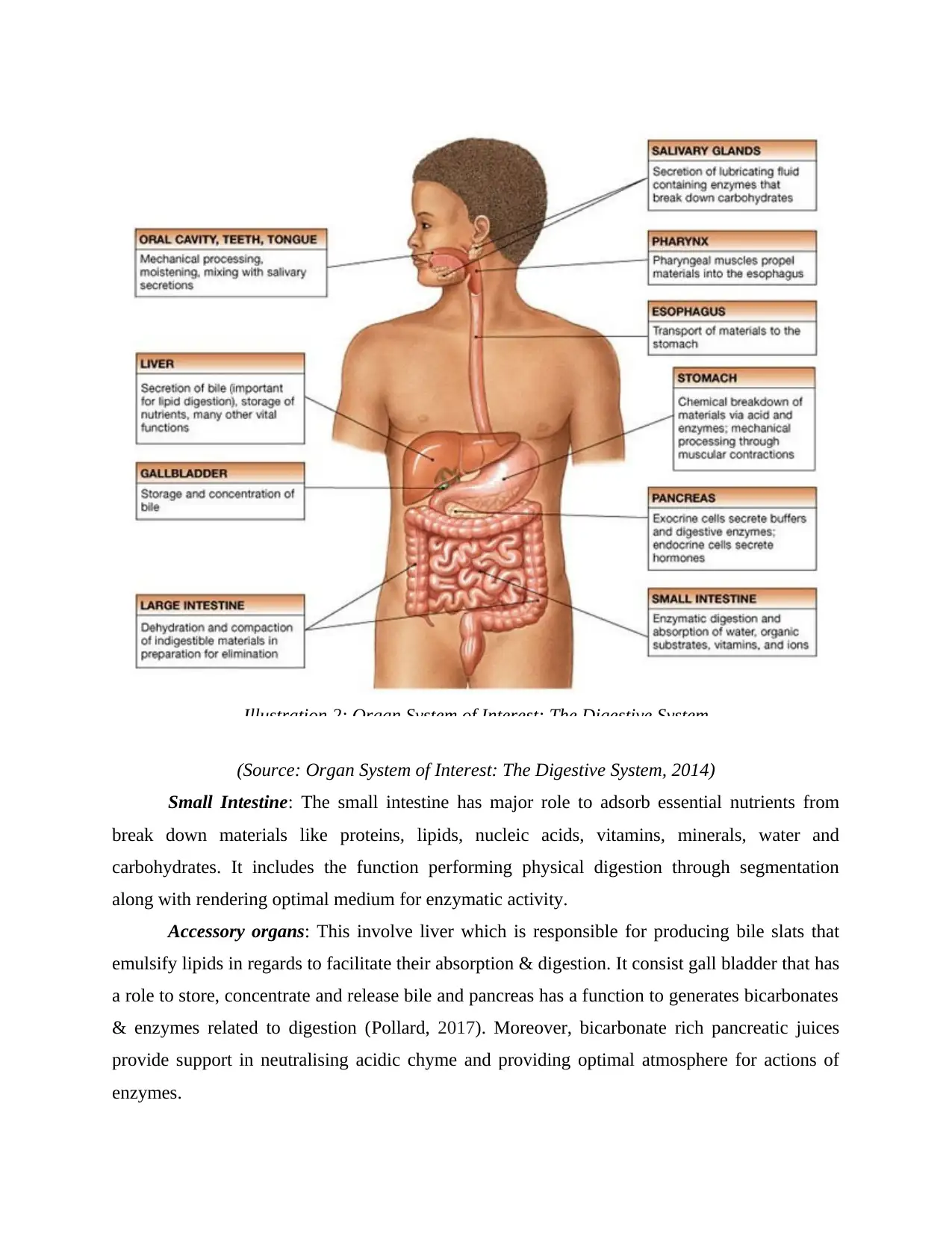
(Source: Organ System of Interest: The Digestive System, 2014)
Small Intestine: The small intestine has major role to adsorb essential nutrients from
break down materials like proteins, lipids, nucleic acids, vitamins, minerals, water and
carbohydrates. It includes the function performing physical digestion through segmentation
along with rendering optimal medium for enzymatic activity.
Accessory organs: This involve liver which is responsible for producing bile slats that
emulsify lipids in regards to facilitate their absorption & digestion. It consist gall bladder that has
a role to store, concentrate and release bile and pancreas has a function to generates bicarbonates
& enzymes related to digestion (Pollard, 2017). Moreover, bicarbonate rich pancreatic juices
provide support in neutralising acidic chyme and providing optimal atmosphere for actions of
enzymes.
Illustration 2: Organ System of Interest: The Digestive System
Small Intestine: The small intestine has major role to adsorb essential nutrients from
break down materials like proteins, lipids, nucleic acids, vitamins, minerals, water and
carbohydrates. It includes the function performing physical digestion through segmentation
along with rendering optimal medium for enzymatic activity.
Accessory organs: This involve liver which is responsible for producing bile slats that
emulsify lipids in regards to facilitate their absorption & digestion. It consist gall bladder that has
a role to store, concentrate and release bile and pancreas has a function to generates bicarbonates
& enzymes related to digestion (Pollard, 2017). Moreover, bicarbonate rich pancreatic juices
provide support in neutralising acidic chyme and providing optimal atmosphere for actions of
enzymes.
Illustration 2: Organ System of Interest: The Digestive System
Paraphrase This Document
Need a fresh take? Get an instant paraphrase of this document with our AI Paraphraser
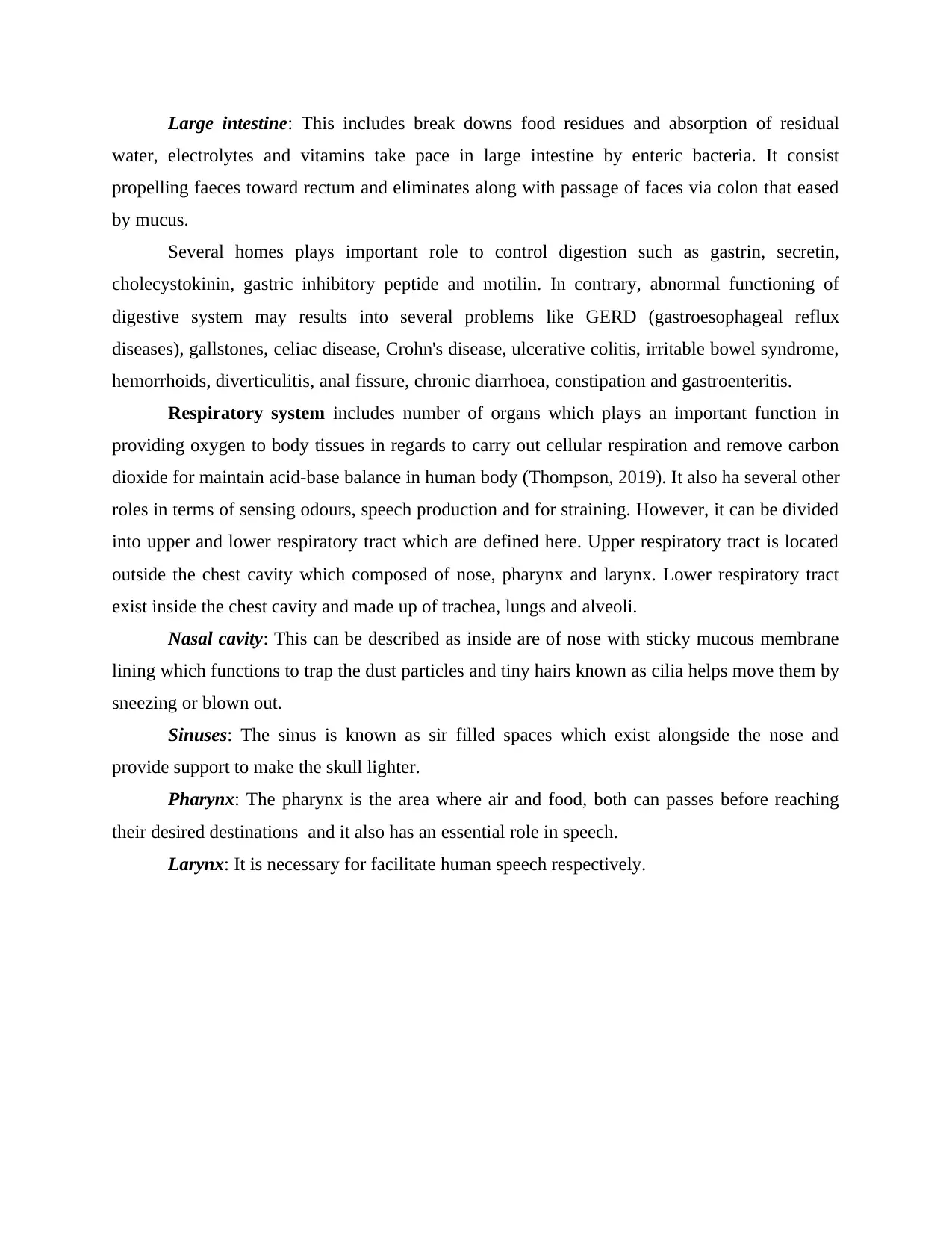
Large intestine: This includes break downs food residues and absorption of residual
water, electrolytes and vitamins take pace in large intestine by enteric bacteria. It consist
propelling faeces toward rectum and eliminates along with passage of faces via colon that eased
by mucus.
Several homes plays important role to control digestion such as gastrin, secretin,
cholecystokinin, gastric inhibitory peptide and motilin. In contrary, abnormal functioning of
digestive system may results into several problems like GERD (gastroesophageal reflux
diseases), gallstones, celiac disease, Crohn's disease, ulcerative colitis, irritable bowel syndrome,
hemorrhoids, diverticulitis, anal fissure, chronic diarrhoea, constipation and gastroenteritis.
Respiratory system includes number of organs which plays an important function in
providing oxygen to body tissues in regards to carry out cellular respiration and remove carbon
dioxide for maintain acid-base balance in human body (Thompson, 2019). It also ha several other
roles in terms of sensing odours, speech production and for straining. However, it can be divided
into upper and lower respiratory tract which are defined here. Upper respiratory tract is located
outside the chest cavity which composed of nose, pharynx and larynx. Lower respiratory tract
exist inside the chest cavity and made up of trachea, lungs and alveoli.
Nasal cavity: This can be described as inside are of nose with sticky mucous membrane
lining which functions to trap the dust particles and tiny hairs known as cilia helps move them by
sneezing or blown out.
Sinuses: The sinus is known as sir filled spaces which exist alongside the nose and
provide support to make the skull lighter.
Pharynx: The pharynx is the area where air and food, both can passes before reaching
their desired destinations and it also has an essential role in speech.
Larynx: It is necessary for facilitate human speech respectively.
water, electrolytes and vitamins take pace in large intestine by enteric bacteria. It consist
propelling faeces toward rectum and eliminates along with passage of faces via colon that eased
by mucus.
Several homes plays important role to control digestion such as gastrin, secretin,
cholecystokinin, gastric inhibitory peptide and motilin. In contrary, abnormal functioning of
digestive system may results into several problems like GERD (gastroesophageal reflux
diseases), gallstones, celiac disease, Crohn's disease, ulcerative colitis, irritable bowel syndrome,
hemorrhoids, diverticulitis, anal fissure, chronic diarrhoea, constipation and gastroenteritis.
Respiratory system includes number of organs which plays an important function in
providing oxygen to body tissues in regards to carry out cellular respiration and remove carbon
dioxide for maintain acid-base balance in human body (Thompson, 2019). It also ha several other
roles in terms of sensing odours, speech production and for straining. However, it can be divided
into upper and lower respiratory tract which are defined here. Upper respiratory tract is located
outside the chest cavity which composed of nose, pharynx and larynx. Lower respiratory tract
exist inside the chest cavity and made up of trachea, lungs and alveoli.
Nasal cavity: This can be described as inside are of nose with sticky mucous membrane
lining which functions to trap the dust particles and tiny hairs known as cilia helps move them by
sneezing or blown out.
Sinuses: The sinus is known as sir filled spaces which exist alongside the nose and
provide support to make the skull lighter.
Pharynx: The pharynx is the area where air and food, both can passes before reaching
their desired destinations and it also has an essential role in speech.
Larynx: It is necessary for facilitate human speech respectively.
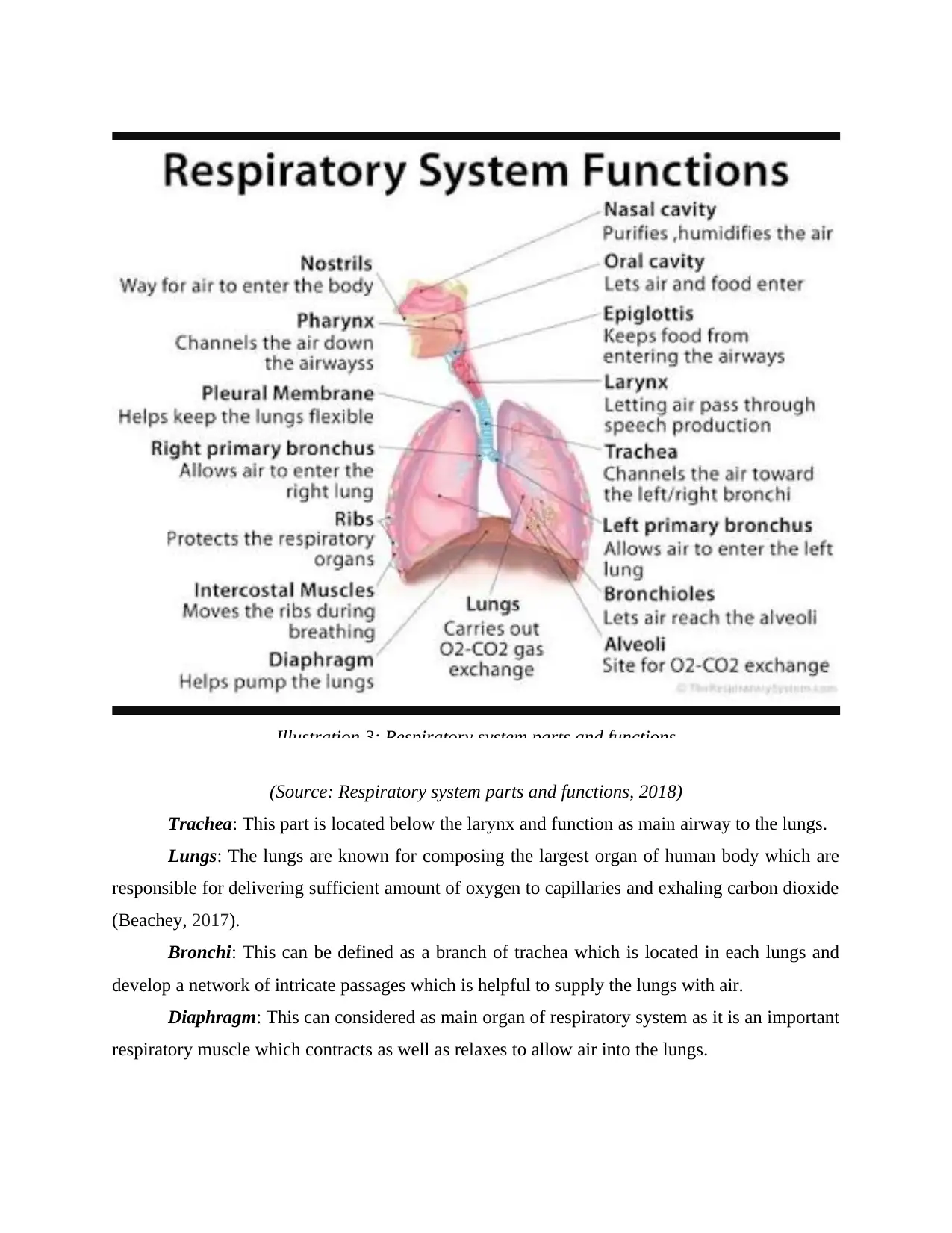
(Source: Respiratory system parts and functions, 2018)
Trachea: This part is located below the larynx and function as main airway to the lungs.
Lungs: The lungs are known for composing the largest organ of human body which are
responsible for delivering sufficient amount of oxygen to capillaries and exhaling carbon dioxide
(Beachey, 2017).
Bronchi: This can be defined as a branch of trachea which is located in each lungs and
develop a network of intricate passages which is helpful to supply the lungs with air.
Diaphragm: This can considered as main organ of respiratory system as it is an important
respiratory muscle which contracts as well as relaxes to allow air into the lungs.
Illustration 3: Respiratory system parts and functions
Trachea: This part is located below the larynx and function as main airway to the lungs.
Lungs: The lungs are known for composing the largest organ of human body which are
responsible for delivering sufficient amount of oxygen to capillaries and exhaling carbon dioxide
(Beachey, 2017).
Bronchi: This can be defined as a branch of trachea which is located in each lungs and
develop a network of intricate passages which is helpful to supply the lungs with air.
Diaphragm: This can considered as main organ of respiratory system as it is an important
respiratory muscle which contracts as well as relaxes to allow air into the lungs.
Illustration 3: Respiratory system parts and functions
⊘ This is a preview!⊘
Do you want full access?
Subscribe today to unlock all pages.

Trusted by 1+ million students worldwide
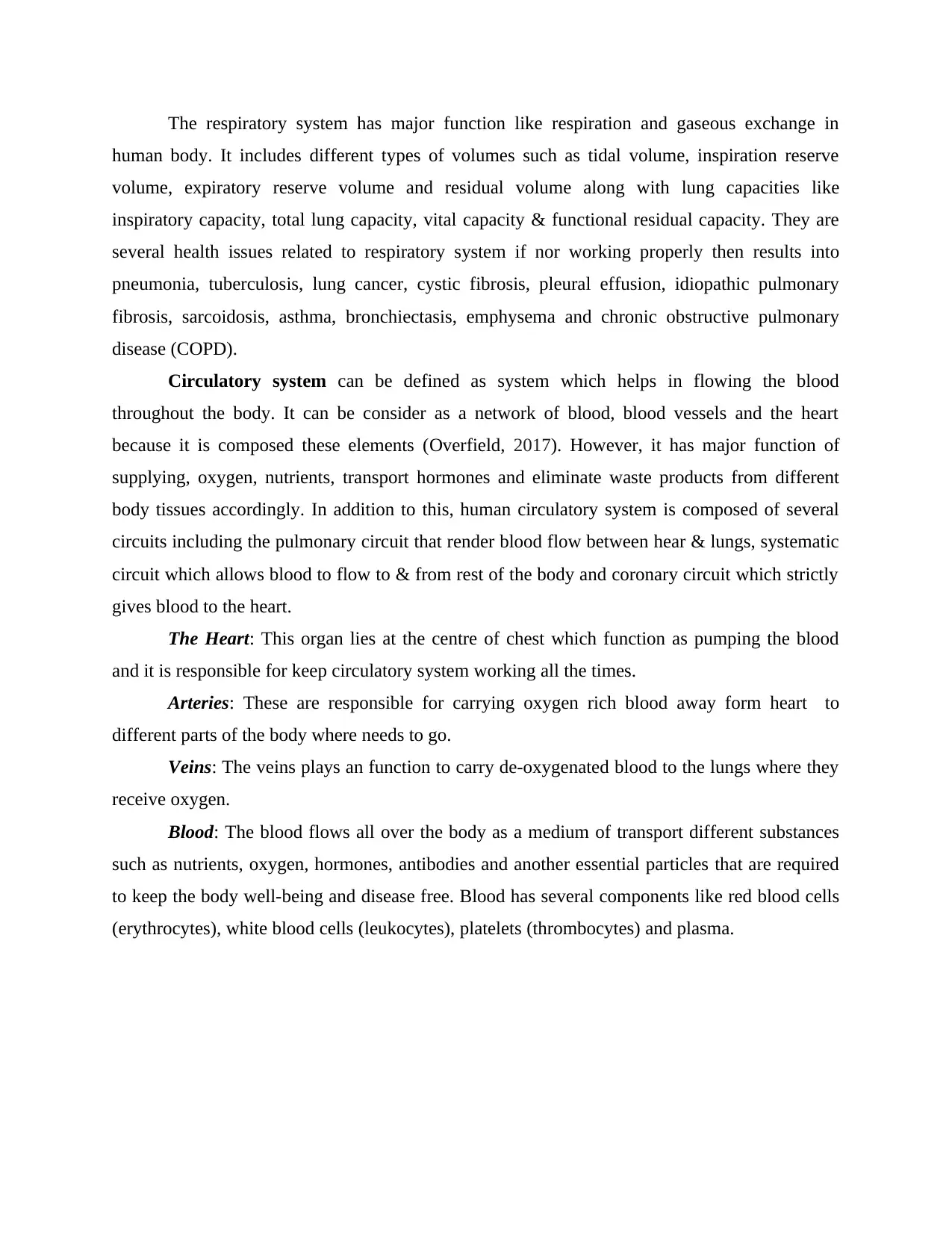
The respiratory system has major function like respiration and gaseous exchange in
human body. It includes different types of volumes such as tidal volume, inspiration reserve
volume, expiratory reserve volume and residual volume along with lung capacities like
inspiratory capacity, total lung capacity, vital capacity & functional residual capacity. They are
several health issues related to respiratory system if nor working properly then results into
pneumonia, tuberculosis, lung cancer, cystic fibrosis, pleural effusion, idiopathic pulmonary
fibrosis, sarcoidosis, asthma, bronchiectasis, emphysema and chronic obstructive pulmonary
disease (COPD).
Circulatory system can be defined as system which helps in flowing the blood
throughout the body. It can be consider as a network of blood, blood vessels and the heart
because it is composed these elements (Overfield, 2017). However, it has major function of
supplying, oxygen, nutrients, transport hormones and eliminate waste products from different
body tissues accordingly. In addition to this, human circulatory system is composed of several
circuits including the pulmonary circuit that render blood flow between hear & lungs, systematic
circuit which allows blood to flow to & from rest of the body and coronary circuit which strictly
gives blood to the heart.
The Heart: This organ lies at the centre of chest which function as pumping the blood
and it is responsible for keep circulatory system working all the times.
Arteries: These are responsible for carrying oxygen rich blood away form heart to
different parts of the body where needs to go.
Veins: The veins plays an function to carry de-oxygenated blood to the lungs where they
receive oxygen.
Blood: The blood flows all over the body as a medium of transport different substances
such as nutrients, oxygen, hormones, antibodies and another essential particles that are required
to keep the body well-being and disease free. Blood has several components like red blood cells
(erythrocytes), white blood cells (leukocytes), platelets (thrombocytes) and plasma.
human body. It includes different types of volumes such as tidal volume, inspiration reserve
volume, expiratory reserve volume and residual volume along with lung capacities like
inspiratory capacity, total lung capacity, vital capacity & functional residual capacity. They are
several health issues related to respiratory system if nor working properly then results into
pneumonia, tuberculosis, lung cancer, cystic fibrosis, pleural effusion, idiopathic pulmonary
fibrosis, sarcoidosis, asthma, bronchiectasis, emphysema and chronic obstructive pulmonary
disease (COPD).
Circulatory system can be defined as system which helps in flowing the blood
throughout the body. It can be consider as a network of blood, blood vessels and the heart
because it is composed these elements (Overfield, 2017). However, it has major function of
supplying, oxygen, nutrients, transport hormones and eliminate waste products from different
body tissues accordingly. In addition to this, human circulatory system is composed of several
circuits including the pulmonary circuit that render blood flow between hear & lungs, systematic
circuit which allows blood to flow to & from rest of the body and coronary circuit which strictly
gives blood to the heart.
The Heart: This organ lies at the centre of chest which function as pumping the blood
and it is responsible for keep circulatory system working all the times.
Arteries: These are responsible for carrying oxygen rich blood away form heart to
different parts of the body where needs to go.
Veins: The veins plays an function to carry de-oxygenated blood to the lungs where they
receive oxygen.
Blood: The blood flows all over the body as a medium of transport different substances
such as nutrients, oxygen, hormones, antibodies and another essential particles that are required
to keep the body well-being and disease free. Blood has several components like red blood cells
(erythrocytes), white blood cells (leukocytes), platelets (thrombocytes) and plasma.
Paraphrase This Document
Need a fresh take? Get an instant paraphrase of this document with our AI Paraphraser
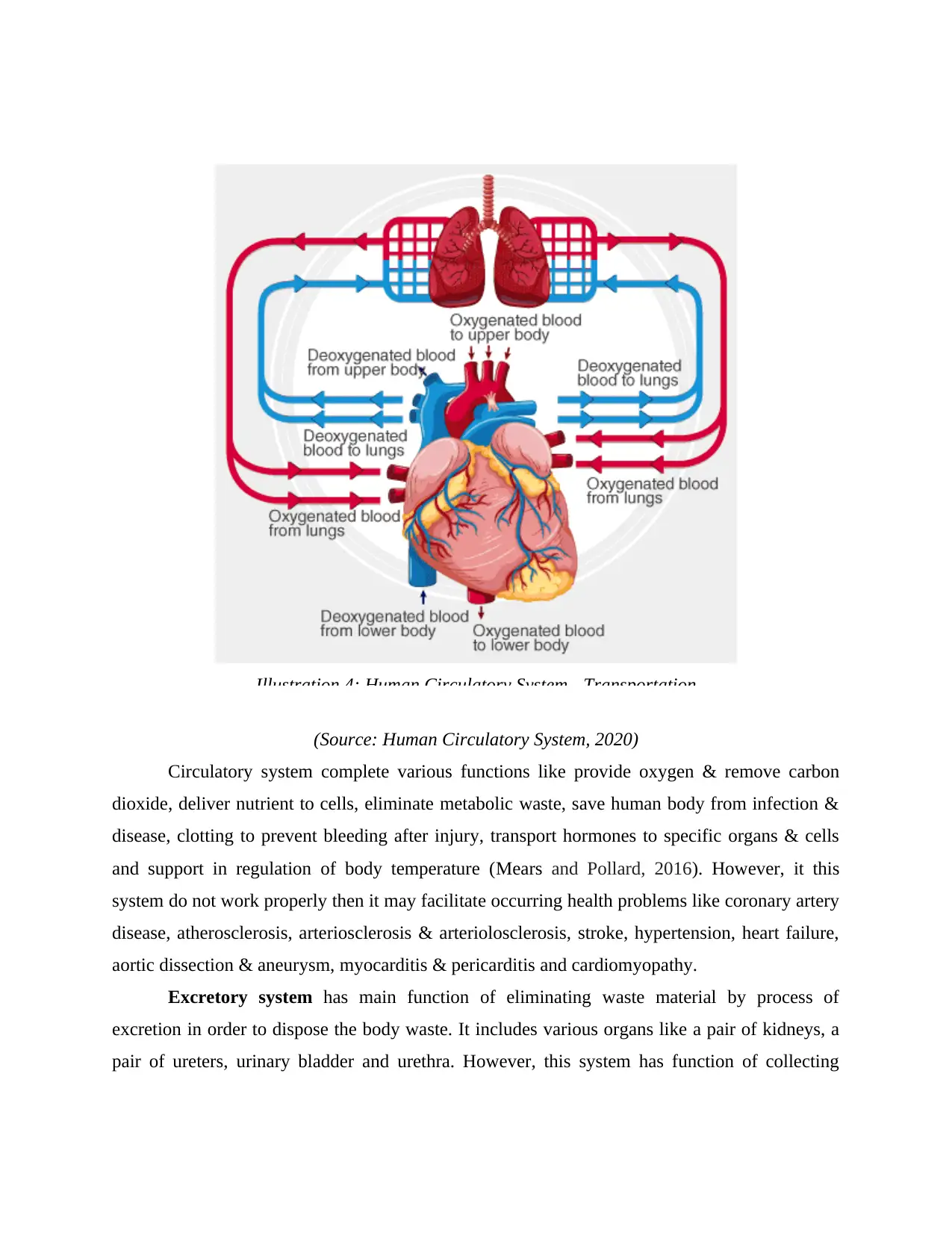
(Source: Human Circulatory System, 2020)
Circulatory system complete various functions like provide oxygen & remove carbon
dioxide, deliver nutrient to cells, eliminate metabolic waste, save human body from infection &
disease, clotting to prevent bleeding after injury, transport hormones to specific organs & cells
and support in regulation of body temperature (Mears and Pollard, 2016). However, it this
system do not work properly then it may facilitate occurring health problems like coronary artery
disease, atherosclerosis, arteriosclerosis & arteriolosclerosis, stroke, hypertension, heart failure,
aortic dissection & aneurysm, myocarditis & pericarditis and cardiomyopathy.
Excretory system has main function of eliminating waste material by process of
excretion in order to dispose the body waste. It includes various organs like a pair of kidneys, a
pair of ureters, urinary bladder and urethra. However, this system has function of collecting
Illustration 4: Human Circulatory System - Transportation
Circulatory system complete various functions like provide oxygen & remove carbon
dioxide, deliver nutrient to cells, eliminate metabolic waste, save human body from infection &
disease, clotting to prevent bleeding after injury, transport hormones to specific organs & cells
and support in regulation of body temperature (Mears and Pollard, 2016). However, it this
system do not work properly then it may facilitate occurring health problems like coronary artery
disease, atherosclerosis, arteriosclerosis & arteriolosclerosis, stroke, hypertension, heart failure,
aortic dissection & aneurysm, myocarditis & pericarditis and cardiomyopathy.
Excretory system has main function of eliminating waste material by process of
excretion in order to dispose the body waste. It includes various organs like a pair of kidneys, a
pair of ureters, urinary bladder and urethra. However, this system has function of collecting
Illustration 4: Human Circulatory System - Transportation
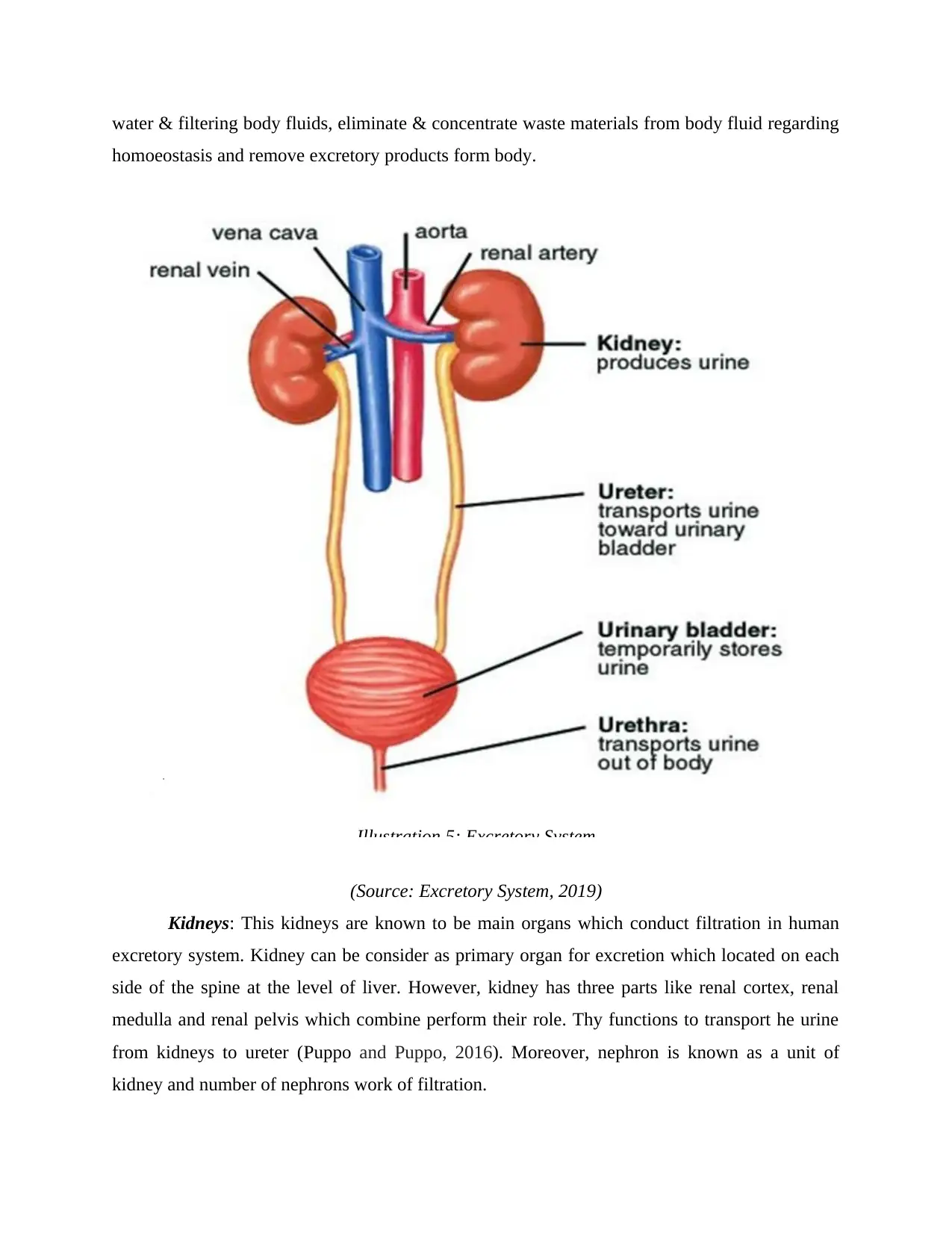
water & filtering body fluids, eliminate & concentrate waste materials from body fluid regarding
homoeostasis and remove excretory products form body.
(Source: Excretory System, 2019)
Kidneys: This kidneys are known to be main organs which conduct filtration in human
excretory system. Kidney can be consider as primary organ for excretion which located on each
side of the spine at the level of liver. However, kidney has three parts like renal cortex, renal
medulla and renal pelvis which combine perform their role. Thy functions to transport he urine
from kidneys to ureter (Puppo and Puppo, 2016). Moreover, nephron is known as a unit of
kidney and number of nephrons work of filtration.
Illustration 5: Excretory System
homoeostasis and remove excretory products form body.
(Source: Excretory System, 2019)
Kidneys: This kidneys are known to be main organs which conduct filtration in human
excretory system. Kidney can be consider as primary organ for excretion which located on each
side of the spine at the level of liver. However, kidney has three parts like renal cortex, renal
medulla and renal pelvis which combine perform their role. Thy functions to transport he urine
from kidneys to ureter (Puppo and Puppo, 2016). Moreover, nephron is known as a unit of
kidney and number of nephrons work of filtration.
Illustration 5: Excretory System
⊘ This is a preview!⊘
Do you want full access?
Subscribe today to unlock all pages.

Trusted by 1+ million students worldwide
1 out of 17
Related Documents
Your All-in-One AI-Powered Toolkit for Academic Success.
+13062052269
info@desklib.com
Available 24*7 on WhatsApp / Email
![[object Object]](/_next/static/media/star-bottom.7253800d.svg)
Unlock your academic potential
Copyright © 2020–2025 A2Z Services. All Rights Reserved. Developed and managed by ZUCOL.





